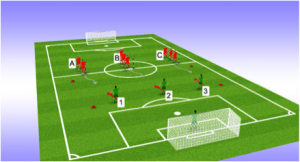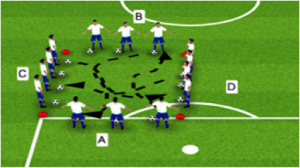By Ljuban Palinic. Image: Australian Sporting Photos
There are so many volunteer parents who dedicate their time to help children in youth sports. Even though my recommendation is that parents should not coach their own child as it can be confusing for the child, I acknowledge and thank all of those parents who do help in providing an opportunity for the next generation of players to a sporting activity and team environment. You as a parent or coach play such an important part in the individual development of children and our future footballers. If you are coaching a team between the ages of 5-11, I wanted to share 9 tips to assist you with your coaching and give you a few suggestions to deliver a quality session, something all our children deserve.
1. Plan and implement sessions that are fun
During these early ages of development, it is extremely important for children to fall in love with the game. It is your responsibility to provide an environment where children feel safe and get the opportunity to learn through fun football games. For best development I encourage you to focus your sessions on creating games that allow for repetition to develop technique and decision making but most importantly on enjoyment of the game.
2. Be patient
Working with children in this age group can be extremely rewarding if you are patient. Do not create expectation. Remember to allow children to be young. Be patient when practicing skills and always assess and reflect on your coaching. If something didn’t go the way you planned it to go; it’s okay. Be patient with yourself and most importantly your players. They are there to learn. Avoid assuming skills/drills are easy for your players. Reflect on your teaching and give yourself space to see if you can deliver the message differently so that it is understood better. Putting pressure on your players has been identified as a major inhibitor to continued participation, so be patient with the developing player.
3. Focus on improving technical skills
A large component of training at this age should focus on developing the footballer’s technical skills. I encourage parents and coaches to give children as much opportunity to get touches on the ball while at training and at home. It is evident that our children in Australia are not on the ball enough and require better technical skills and football intelligence to reach the highest level of football. Over the last 10 years we have had a decrease of players from Australia playing in top leagues across the world. Use your time wisely and give children every opportunity in becoming the best they can be.
According to Paul Okon, current Central Coast manager and previous U20 Australian National Youth coach, children need to spend more time on the ball to improve their technical skills especially in the time away from training. They need to dedicate more time away from training to have any chance of being world class players. To ensure you assist this process allow for repetition of technical skills to occur through games.
4. Focus on one skill per training session
Avoid focusing on too much too soon. Keep it simple! At times this can be difficult as coaches want to make things perfect. Keep in mind developing a player is a long journey and it is important to understand football is a step by step process – we can’t teach everything within one session, one year or even 5 years. Be patient and stay focused to the skill you are working on for that particular session. Ensure you don’t get easily side tracked with your urge to fix everything!
5. Create one chaos game per session
I encourage each parent and coach to create one chaos drill for each session that incorporates the skill you are working on. A chaos drill helps to develop player awareness through hidden learning. While practicing the particular skill and creating congestion where it is difficult for players to get out of, you are encouraging problem solving and game awareness. For example; see the drill below – very simple but extremely effective in developing game awareness through hidden learning for our developing players.
Drill 1 – is a 1v1 drill that focuses on taking on a defender. However, when three players are going at the same time it also creates an opportunity for hidden learning. Components such as awareness of space is one element within chaos drills. The congestion creates an environment for players to be more aware of their surroundings and decide which direction it would be best to attack in. That being said it is very important to not take away the essence of the skill you are working on as that is your focus.

Drill 2 – is an example of a running with the ball chaos drill where players need to run to the opposite side of the grid at the same time as another group. For example players on sides A & B need to get across to the opposite side when you call A & B. To increase the difficulty you can increase the number of groups involved at one time (i.e. A, B, C & D). Then make it more difficult to increase the intensity and improve speed of player awareness you can put a time restraint (i.e. “you have 7 seconds to get across to the other side”).

Be mindful for younger players as safety is priority and decisions around how many players go at the one time needs to always be considered to prevent accidents. The younger the child the less number of players going at one time.
6. Be enthusiastic, approachable and professional
Being enthusiastic, approachable and professional are the basic values to incorporate as a coach. When I say enthusiastic I mean controlled enthusiasm. Avoid running down the sideline shouting shoot, score, pass, dribble and kick it long. This will only decrease your player’s chances of learning. Being enthusiastic means caring about your players and their development, about the session you are implementing and for the improvement your players make regardless of the level.
When working with children of this age group it is really important to be approachable and ensure they enjoy their time at football. Make all players feel welcome regardless of their skill level and allow them to be children who fall in love with the sport.
Most importantly be professional in your teaching and behaviour. You have a responsibility, obligation and duty of care to the next generation of footballers and children.
7. Focus on the process not the result
I always advise every parent and coach working with children of this age that if the process is correct the result will follow, so avoid focusing on only the scoreboard. During these ages our children need to learn as much as possible. Give them this opportunity and avoid the win at all cost mentality.
8. Play small-sided games with a maximum of 5v5
Small sided games are essential in developing a variety of key components in great footballers. Small sided games are firstly fun for children of this age and something they all love. That being said, be mindful of the number of players in each grid. My advice is to play no more than 5 V 5 in each grid. Remember the aim for children of this age group is to get plenty of touches on the ball. More players results in less touches, less touches means less chance of developing technique. Also take note of the size of the grid you create for the small sided game. Keep it big enough to have a flowing game but tight enough to create an environment where hidden learning can occur (tighter areas = quicker speed of thought, quicker decision making and more comfortable players under pressure).
9. Avoid giving too much information
I encourage all coaches of this age to avoid giving too much information during weekend games. Give your players the opportunity to figure it out. Sit back, relax and enjoy the development opportunity you are giving to your players. The week’s training is your time to teach, the game is your time to guide and observe if your players are able to implement your weeks work. If you identify an issue that is reoccurring use questioning with guidance to help children work it out on their own. If you give them every answer and too much information they won’t be able to figure it out on their own when they are on the pitch.
Originally published on Football Technique Australia

